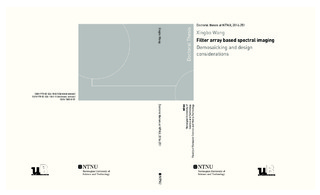| dc.contributor.advisor | Thomas, Jean-Baptiste | |
| dc.contributor.advisor | Hardeberg, Jon Yngve | |
| dc.contributor.advisor | Gouton, Pierre | |
| dc.contributor.author | Wang, Xingbo | |
| dc.date.accessioned | 2016-10-25T09:26:26Z | |
| dc.date.available | 2016-10-25T09:26:26Z | |
| dc.date.issued | 2016 | |
| dc.identifier.isbn | 978-82-326-1840-8 | |
| dc.identifier.isbn | 978-82-326-1841-5 (electronic version) | |
| dc.identifier.issn | 1503-8181 | |
| dc.identifier.uri | http://hdl.handle.net/11250/2417431 | |
| dc.description.abstract | Spectral imaging apparatus in current use are often cumbersome, costly and slow in operation, which becomes a major obstacle to extensive use of spectral imaging in several application areas. In recent years, the technical and commercial success of color filter array (CFA) based imaging systems has motivated researchers to generalise and expand the concept of CFA to achieve efficient spectral imaging through the use of the spectral filter array (SFA). This dissertation expounds the research into the filter array approach to spectral imaging based on a simulation framework, from the development of demosaicking methods to the design and evaluation at the system level. The dissertation first presents the development of the field of spectral imaging from its roots in spectroscopy and imaging, and explores the state-of-the-art solutions based on SFA from design to realisation. It then proposes a simulation framework composed of the major parts in a typical imaging pipeline. Based on this, the influence of chromatic aberration on CFA demosaicking and the impact of filter bandwidth on spectral reconstruction were evaluated. The results helped to better understand the delicate interactions between the components in the pipeline and verify the validity of the simulation framework. On the basis of the framework, three novel SFA demosaicking methods were developed and evaluated. The methods differ fundamentally and thus featuring distinct properties, as confirmed by the experimental results. The key to understanding the differences lies in the way demosaicking methods deal with the spatial and spectral correlation between pixels in a mosaicked image. An evaluation of the colorimetric performance shows that a properly designed SFA-based imaging system may also be useful for colour image acquisition. Lastly, performance of the proposed and conventional demosaicking methods were scrutinised, given the characteristics and parameters of a real-world SFA sensor design. We conclude that, for a successful SFA-based spectral imaging system design, it is important to consider carefully the joint influence of all the involved modules as well as the requirements and constraints of applications. And we hope that the use of SFA based spectral imaging is expected to be wider in the foreseeable future in the light of technological advances and market demand. | nb_NO |
| dc.language.iso | eng | nb_NO |
| dc.publisher | NTNU | nb_NO |
| dc.relation.ispartofseries | Doctoral thesis at NTNU;2016; | |
| dc.relation.ispartofseries | ;251 | |
| dc.subject | Filter array based spectral imaging | nb_NO |
| dc.subject | Demosaicking | nb_NO |
| dc.subject | Design considerations | nb_NO |
| dc.subject | Spectral Imaging Technology | nb_NO |
| dc.subject | Spectral Imaging | nb_NO |
| dc.subject | Colorimetric performance | nb_NO |
| dc.title | Filter array based spectral imaging : Demosaicking and design considerations | nb_NO |
| dc.type | Doctoral thesis | nb_NO |
| dc.subject.nsi | VDP::Technology: 500::Information and communication technology: 550::Computer technology: 551 | nb_NO |
